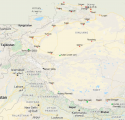Just as it is a mistake to underestimate your opponent, it can be just as dangerous to overestimate them.
India has zero plans to ‘free’ Tibet, never mind all the other nonsense fantasising they are doing with maps. If anything, the amount of energy they are devoting to such obviously pointless activity speaks volumes about their actual capabilities and options.
Indian intransigence on the boarder issue are born largely out of two main factors. One is that they indeed acutely feel the threat from China and would love to have an independent Tibet as buffer; and the other is that Indian politicians and media love to blame everything on China as a cheap and convenient way of shirking responsibility and uniting their unwashed masses against a common external boogeyman least they start to see the inequalities and injustices at home right in front of their eyes.
On the strategic boarder issue, well India has zero concrete viable options to split Tibet away from China, so their strategy is very much a wait and hope one. They have minimal capabilities to ferment unrest or organising and supporting any effective insurgency efforts inside Tibet (which those who are far more capable have tried and failed for decades); nor do they have the raw power to dissuade China from all out war if they were so idiotic and when that scheme gets uncovered (which it will be, and soon).
On the boogeyman front, well that’s pretty obvious, and one needs to look no further than that earlier this year with Indian stories about China ‘training’ the locust plague devastating India.
The problem for India is that they have made short term band-aid stalling tactics into institutionalised policy on the ‘blame China for everything’ front, which is bleeding into its long term back burner ‘Free Tibet’ secret hope.
You can only tell your peasants to ‘blame China’ for all their problems for so long before the peasants start demanding you do something about this terrible boogeyman ruining all their lives all the time. Hence the pressure and need for India to make meaningless salami tactic encroachment on China whenever the internal pressure for action grows too much, and/or they sense a moment of weakness or distraction on the part of China that might take advantages of, so the Indian government and press and sell any tiny gain as some great almighty victory to ease the pressure on them to ‘act tough‘ on China.
I bet that if anyone was bored and heroic enough to endue the filth, they can find growing Indian domestic pressure to ‘respond’ to China on some stupid made up slight preceding every previous Indian incursion and clash.
Add to that Indian soldiers who grew up being told China is the source of all evil and cause of all their ills gets hot headed and emotional when they see actual Chinese soldiers, especially Chinese soldiers who are better equipped and provisioned than them, and all that misdirected rage just boils up uncontrollably leading to meaningless clashes when they were supposed to just test the waters to see if there are any opportunities to exploit without the Chinese noticing as India was hoping for China to be too distracted and weakened by COVID19 and American attempts to start a new Cold War to notice or care about some meaningless crap they pull on the boarder.
Problem for them is that China has already pretty much fully recovered from COVID19, and is pretty sensitive about any possibility of just the kind of probing that India attempted.
The Indian government quickly realised there was no weakness to exploit, so were busy de-escalating, when their hothead Colonel decided to try to force the government’s hand by going against orders and starting a war himself. He (rightly) reasoned that once the war has started, the Indian press would hail him a national hero and the Indian government would have no choice but to throw their full support behind him and cover up the fact that he went against orders. So what if his military career is finished after this? With the National fame and adulation he is sure to get, that would have been the perfect springboard to a new life in politics where riches and luxury awaits. Too bad for him his fighting abilities were nowhere near his ego. He deserved what he got, it’s his men who died needlessly got his ego and ambition that I feel sorry for. But rather than blaming the man responsible, they blame China. A pretty accuracy microcosm of India’s National game.



